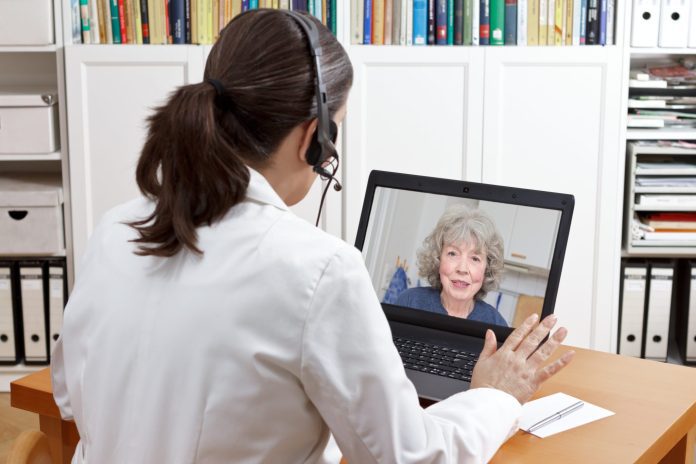Virtual patient interactions and remote patient monitoring are key connected healthcare use cases
The primary use case for connected healthcare is currently telemedicine–a patient interfacing with a medical professional via videoconference. Meeting with a medical professional using a desktop, laptop, tablet or smartphone hinges on connectivity, whether it’s cellular, Wi-Fi or a wired connection. While you could make the case that this use case sits under the umbrella of IoT–the aforementioned devices are most certainly things–a more pure representation of an IoT connected healthcare use case would be remote patient monitoring wherein medical devices of varying degrees of specialization provide physicians with a more regular stream of patient data, things like blood pressure, blood sugar levels, heart rate, and the like. Equipped with more patient-related data than could be gathered during a typical appointment, clinical staff gains a more clear picture of the patient’s well being; this allows for more accurate, effective diagnoses, treatment plans, and outcomes.
In a study conducted in 2020 by Samantha Tam, MD, MPH, of the Department of Otolaryngology—Head and Neck Surgery of the Henry Ford Health System and Henry Ford Cancer Institute in Detroit, and focused on uptake of telemedicine in patients being treated for head and neck cancer, the use of telemedicine surged during COVID-19 as clinics shut down. According to figures published in Nov. 2020 by the JAMA Network, between March 14 and April 24 last year, of 346 encounters with 234 patients, 25% were in person, 49.1% were virtual, and 23.6% were conducted over the telephone. In 2019 there were no telemedicine visits. Tam also found that a lower completion rate of virtual visits was seen among patients based on multivariable adjustment for insurance type, household income, education level, low median household income, and other factors.
Regarding the finding around lower completion rates of virtual visits seen in the patient group studied, Tam wrote that, “This disparity was not demonstrated in telephone calls. While synchronous audio and visual communication in virtual visits offer a more comprehensive assessment, telephone visits may be an important avenue to access care.
McKinsey & Company has also tracked the uptake of telehealth during the pandemic closely. According to the authors of the report “Telehealth: A quarter-trillion dollar post-COVID-19 reality?,” the use of telehealth for office and outpatient visits grew 78 times between February and April, 2020. By July they found that the use of telehealth “stabilized at levels 38X higher than before the pandemic.” This is driven by three factors detailed in the report: “1) increased consumer willingness to use telehealth, 2) increased provider willingness to use telehealth, 3) regulatory changes enabling greater access and reimbursement.” During the pandemic, “telehealth offered a bridge to care, and now offers a chance to reinvent virtual and hybrid virtual/in-person care models, with a goal of improved healthcare access, outcomes, and affordability.”
The McKinsey team estimated in 2019 “that up to $250 billion of U.S. healthcare spend could potentially be shifted to virtual or virtually enabled care. They write that “investment in virtual care and digital health more broadly has skyrocketed, fueling further innovation…” and “Virtual healthcare models and business models are evolving and proliferating,” with services expanding in range and focus areas.
Remote patient monitoring effectively extends the reach of data collection out of clinical settings and into the world beyond the four walls of a healthcare facility. Instead of point-in-time data, physicians and other medical workers can collect more data and make better, more effective care and treatment decisions.
In an analysis of 91 studies focused on remote patient monitoring published by medical trade journal BMJ in March this year, researchers from the Centre for Health Services Research at the University of Queensland found the most common metrics remotely monitored are heart rate, blood pressure, weight, and oxygen saturation. Cardiac implantable electronic devices (CIEDs) were also used to glean data about heart rhythm and arrhythmic episodes. Technologies used for remote patient monitoring included dedicated units or hubs, CIEDs, pacemakers, tablet- and smartphone-based applications, websites, electronic health diaries, inhalers, medication devices, scales, pulse oximeters, and thermometers.
According to the authors, remote patient monitoring “for all disease conditions was reported to have reduced admissions, length of stay and [emergency department] presentations…” in more than 40% of the studies reviewed. The other half of studies considered in the analysis “largely reported no change in acute care use for remotely monitored patients. A very small number of studies report RPM increased acute care use.”
In its own analysis, network equipment provider Ericsson looked at how 5G could enable digital transformation in the healthcare sector and found four use cases categories:
- Patient-centered, out-of-hospital, application like precision medicine, remote monitoring, alert delivery, and administration of medicine
- In-hospital applications such as telemetry and VR-based surgical training
- Medial data management applications, including real-time data set transmission and electronic recordkeeping
- And other applications that accelerate care delivery like 3D printing and ambulance drones
Then there’s the long-discussed 5G-enabled healthcare application—remote robotic surgery. While this particular example is far from mainstream, Ericsson did scope out the required network resources that would be necessary to deliver remote robotic surgery. This could potentially give an idea of the technologies the healthcare sector will evaluate, deploy and use in the future. According to the equipment vendor, 1 millisecond latency is needed for haptic feedback; high throughput will support HD imagery streaming; high network availability and minimal packet loss will allow an uninterrupted procedure; and mission-critical security given potentially life-threatening implications of a breach.

